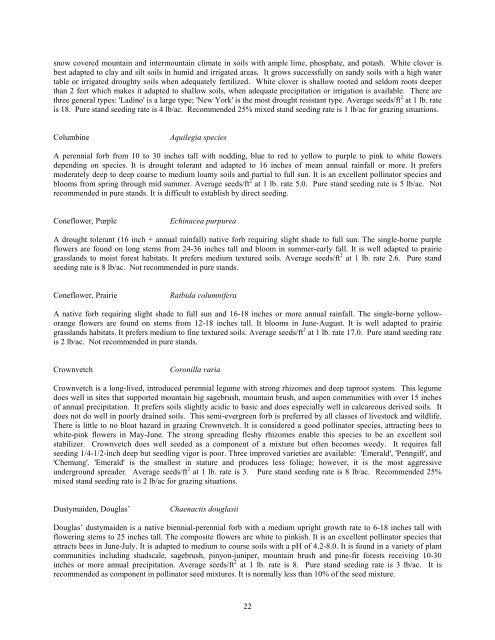Idaho Plant Materials Technical Note No. 24
Idaho Plant Materials Technical Note No. 24
Idaho Plant Materials Technical Note No. 24
Create successful ePaper yourself
Turn your PDF publications into a flip-book with our unique Google optimized e-Paper software.
snow covered mountain and intermountain climate in soils with ample lime, phosphate, and potash. White clover is<br />
best adapted to clay and silt soils in humid and irrigated areas. It grows successfully on sandy soils with a high water<br />
table or irrigated droughty soils when adequately fertilized. White clover is shallow rooted and seldom roots deeper<br />
than 2 feet which makes it adapted to shallow soils, when adequate precipitation or irrigation is available. There are<br />
three general types: 'Ladino' is a large type; 'New York' is the most drought resistant type. Average seeds/ft 2 at 1 lb. rate<br />
is 18. Pure stand seeding rate is 4 lb/ac. Recommended 25% mixed stand seeding rate is 1 lb/ac for grazing situations.<br />
Columbine<br />
Aquilegia species<br />
A perennial forb from 10 to 30 inches tall with nodding, blue to red to yellow to purple to pink to white flowers<br />
depending on species. It is drought tolerant and adapted to 16 inches of mean annual rainfall or more. It prefers<br />
moderately deep to deep coarse to medium loamy soils and partial to full sun. It is an excellent pollinator species and<br />
blooms from spring through mid summer. Average seeds/ft 2 at 1 lb. rate 5.0. Pure stand seeding rate is 5 lb/ac. <strong>No</strong>t<br />
recommended in pure stands. It is difficult to establish by direct seeding.<br />
Coneflower, Purple<br />
Echinacea purpurea<br />
A drought tolerant (16 inch + annual rainfall) native forb requiring slight shade to full sun. The single-borne purple<br />
flowers are found on long stems from <strong>24</strong>-36 inches tall and bloom in summer-early fall. It is well adapted to prairie<br />
grasslands to moist forest habitats. It prefers medium textured soils. Average seeds/ft 2 at 1 lb. rate 2.6. Pure stand<br />
seeding rate is 8 lb/ac. <strong>No</strong>t recommended in pure stands.<br />
Coneflower, Prairie<br />
Ratbida columnifera<br />
A native forb requiring slight shade to full sun and 16-18 inches or more annual rainfall. The single-borne yelloworange<br />
flowers are found on stems from 12-18 inches tall. It blooms in June-August. It is well adapted to prairie<br />
grasslands habitats. It prefers medium to fine textured soils. Average seeds/ft 2 at 1 lb. rate 17.0. Pure stand seeding rate<br />
is 2 lb/ac. <strong>No</strong>t recommended in pure stands.<br />
Crownvetch<br />
Coronilla varia<br />
Crownvetch is a long-lived, introduced perennial legume with strong rhizomes and deep taproot system. This legume<br />
does well in sites that supported mountain big sagebrush, mountain brush, and aspen communities with over 15 inches<br />
of annual precipitation. It prefers soils slightly acidic to basic and does especially well in calcareous derived soils. It<br />
does not do well in poorly drained soils. This semi-evergreen forb is preferred by all classes of livestock and wildlife.<br />
There is little to no bloat hazard in grazing Crownvetch. It is considered a good pollinator species, attracting bees to<br />
white-pink flowers in May-June. The strong spreading fleshy rhizomes enable this species to be an excellent soil<br />
stabilizer. Crownvetch does well seeded as a component of a mixture but often becomes weedy. It requires fall<br />
seeding 1/4-1/2-inch deep but seedling vigor is poor. Three improved varieties are available: 'Emerald', 'Penngift', and<br />
'Chemung'. 'Emerald' is the smallest in stature and produces less foliage; however, it is the most aggressive<br />
underground spreader. Average seeds/ft 2 at 1 lb. rate is 3. Pure stand seeding rate is 8 lb/ac. Recommended 25%<br />
mixed stand seeding rate is 2 lb/ac for grazing situations.<br />
Dustymaiden, Douglas’<br />
Chaenactis douglasii<br />
Douglas’ dustymaiden is a native biennial-perennial forb with a medium upright growth rate to 6-18 inches tall with<br />
flowering stems to 25 inches tall. The composite flowers are white to pinkish. It is an excellent pollinator species that<br />
attracts bees in June-July. It is adapted to medium to course soils with a pH of 4.2-8.0. It is found in a variety of plant<br />
communities including shadscale, sagebrush, pinyon-juniper, mountain brush and pine-fir forests receiving 10-30<br />
inches or more annual precipitation. Average seeds/ft 2 at 1 lb. rate is 8. Pure stand seeding rate is 3 lb/ac. It is<br />
recommended as component in pollinator seed mixtures. It is normally less than 10% of the seed mixture.<br />
22
















